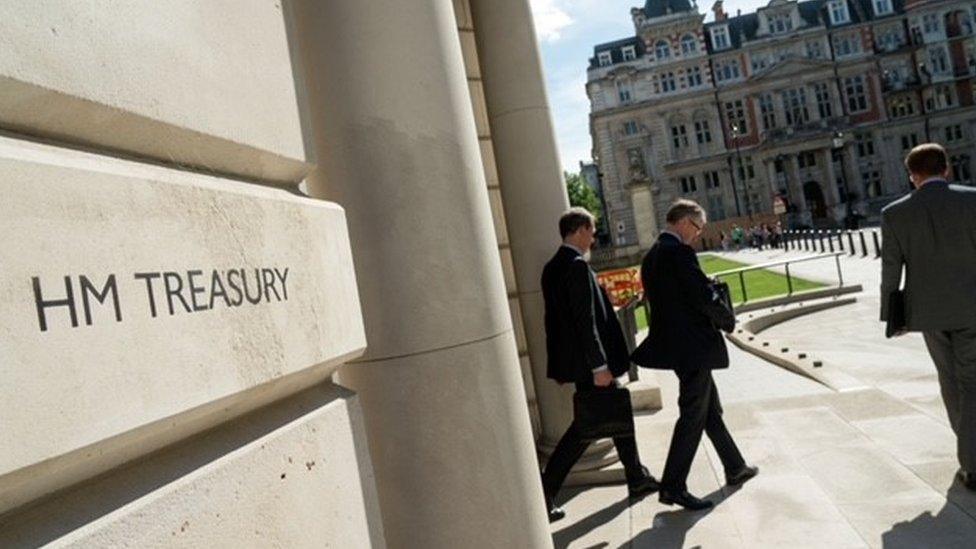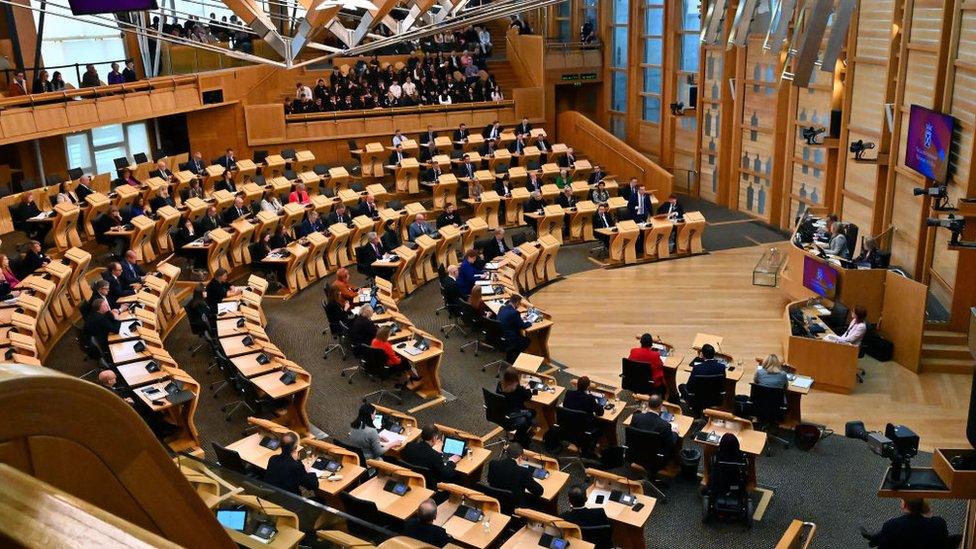Funding Holyrood: Agreeing a fair share
- Published

It's extremely dry and complex, but the deal on allocating funds from the Treasury to the Scottish government means many billions of pounds over time for public services and welfare.
Holyrood borrowing powers are being increased and the limits linked to inflation, but there are parts of the deal which are more significant because the funding formula won't change, and the key one is to Holyrood's advantage.
The Scottish and UK governments don't appear to agree on much, but there are times when, quietly, they can rub along just fine.
If you don't hear much about it, that may be because there's little party political advantage in consensus, or because the news media isn't interested in reporting that peace has broken out.
But sometimes, agreement is reached when it really matters. Wednesday was such a moment, with the announcement that they have agreed on the arrangements for funding the Scottish government.
Stick with this. It's an agreement through which £33bn came Holyrood's way in 2020-21, and small changes in it could have delivered hundreds of millions of pounds less.
You may recall the two governments agreed on a new funding formula in 2016, publishing something called the Fiscal Framework. This was required to account for the ways in which devolved income tax and welfare spending would reduce the size of the block grant passed each year from the Treasury to the Scottish finance secretary.
You may also recall that there have been some spats about the way the framework works, or more often when it doesn't - during the splurging of cash in response to the pandemic, for instance, when the Scottish government wasn't sure what it could expect as a share of UK spend.

The latest deal could be a positive one for the Scottish government at Holyrood
And as a keen observer of these things, you would surely be aware that the Scottish government believes it should have considerably more wiggle room, if not the barn door opened, on its ability to borrow.
You may, on the other hand, have had more interesting things to do than monitor the mechanism of the Fiscal Framework. Even Test cricket has, reportedly, been relatively interesting this summer.
But this is a moment to take stock, as the UK and Scottish governments agreed they would do after five years of the Fiscal Framework in operation.
The revised framework announced on Wednesday makes some minor but important changes, and some important non-changes.
It lifts the ceiling on borrowing as a means of ironing out anomalies in spending. The block grant relies on the inexact science of forecasting lots of revenue streams, which is done by the Scottish Fiscal Commission. As these are inevitably wrong, sometimes by a lot and more often to the downside, there are subsequent reconciliations, next year getting close to £400m.
Bigger borrowing powers help the Scottish government to handle that extra bill, doubling the maximum that can be borrowed for day-to-day or resource budgets, to £600m each year.
'Horribly complex'
Whereas Holyrood's borrowing ceilings were fixed, inflation has since eroded their value by around 20%. So there's agreement that they will be raised each year to take account of future price increases.
More significant, however, is what has not changed. There is still no sign that the two governments can agree a way of assigning half of VAT receipts in Scotland to the Scottish government.
That was planned after the Smith Commission reviewed the extent of devolved powers in the wake of the independence referendum. But both sides are happy not to push that to implementation, because it looks horribly complex. The fiscal gain looks like it is far outweighed by the potential administrative and political pain.
What is also missing is any change to the complicated means by which the Treasury block grant is adjusted each year. And that non-change makes a big difference.
To back-pedal and to simplify, in brief, when the Treasury handed over income tax powers to Holyrood, there was agreement that it would reduce the block grant by the amount of money that it would have expected to raise from Scottish tax-payers if UK tax rates and thresholds had continued to apply in Scotland. It did the same with the power to tax property transactions, formerly known as stamp duty and now the Land and Buildings Transaction Tax.
So if Scotland can grow its tax base faster than the UK, it should come out ahead in revenue and enjoy the spoils. If it grows more slowly, Holyrood has to cut its cloth accordingly, and either raise tax or cut spending or both.
But each year, Westminster's budget grows, and one of the reasons it grows is because immigration brings more people, paying more tax. That growth is significantly higher in the UK than in Scotland, and there's not much Holyrood can do to change that. So how to count that budget change and apply it fairly to the block grant.
Deep roots
The solution agreed in 2016 was to use an index that captured relative population change. That protected Scotland from the effect of its population growing more slowly than the rest of the UK, and therefore its tax base doing likewise.
As Scottish finance secretary back then, John Swinney is credited with having insisted on that. And the evidence now is that it has secured hundreds of millions of pounds - perhaps half a billion - that would otherwise have been deducted by an index that did not take population change into account.
The Treasury was expected to challenge that index at this review. The Institute of Fiscal Studies tells us that it is unfair to taxpayers in the rest of the UK, in that a portion of their income tax is still being allocated to Holyrood. If its continuation was, indeed, challenged by the Treasury at this review, the Scottish government appears to have won again, because that same index is retained.
For how long? There's no reference to the next review. Some such formulas for distributing funds can get stuck because they're too difficult to change.
Hence, we still have the Barnett Formula, as the basis of adjustments to the block grant for Scotland, Wales and Northern Ireland, 45 years after Treasury minister Joel Barnett devised it as a short-term fix to resolve disagreements in Jim Callaghan's Labour cabinet.
Having survived six years, the Fiscal Framework seems to have put down sufficiently deep roots that it could also be around for a while. But it will be tested more over time, as anomalies attach to it, and if the Scottish tax base continues to grow more slowly for reasons other than population change.
